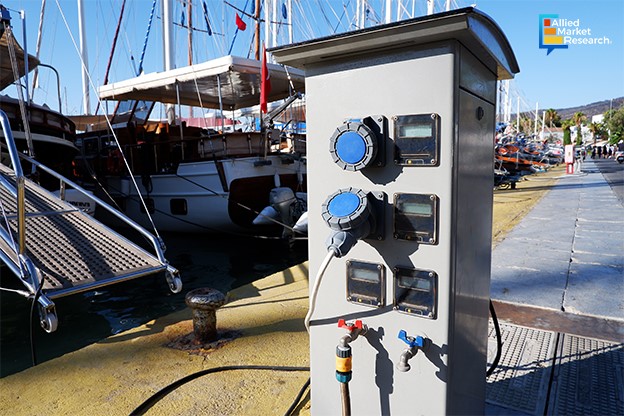Shore Power Systems: Cleaner Port Operations for Ships

30 May
2025
Highlights:
- Introduction
- Shore power cutting pollution
- Cruise lines and ports investing in shore power systems
Shore power systems are changing the way ports and vessels manage their energy use. These systems allow ships to plug into the local electricity grid while docked, so they can turn off their engines. This helps reduce noise, lower emissions, and save fuel. With ports and shipping companies facing constant pressure to reduce pollution, shore power is becoming more common in container terminals and cruise ports.
Growing Investment in Shore Power Infrastructure
The shipping industry is taking shore power quite seriously. In May 2025, Cavotec signed a deal worth €8.1 million to provide shore power units for container vessels. These systems will be installed in Europe and are expected to help cut air pollution around ports. Cavotec’s equipment will allow ships to shut down their engines and connect to cleaner electricity while loading and unloading cargo.
In another major step, SeaCap, a newly formed capital partner, was launched as the first financial service platform dedicated to shore power. It aims to help cruise ports fund and build shore power facilities. Ports often struggle with the high cost of upgrading their power systems, but SeaCap plans to make funding easier through long-term partnerships. The company was started by experts from Royal Caribbean and global energy firms who understand both cruise operations and energy infrastructure.
Cruise Industry Leading the Adoption
Cruise lines have started investing heavily in shore power solutions. Royal Caribbean, Carnival, and Norwegian Cruise Line have all added shore power capabilities to some of their ships. This helps them meet stricter rules on emissions, especially in ports like Seattle, Vancouver, and parts of California where shore power use is encouraged or required. Several new cruise terminals are also being built with shore power systems already in place, showing a stronger focus on sustainable port design.
In a report published by MSN in May 2025, it was noted that cruise ports and cities are working together to expand access to shore power. This cooperation is helping reduce local air pollution and improve community health. For example, when ships use shore power instead of fuel while docked, it cuts the release of harmful substances like sulfur oxides and fine particles. These pollutants can affect people living near busy ports. The shore power industry is expected to generate revenue of $3.8 billion by 2030. The market accounted for $1.8 billion in 2023 and is projected to rise at a CAGR of 11.4% during 2024-2030.
Technical and Operational Considerations
Using shore power is not as simple as plugging in a household appliance. Ships need to be built or retrofitted with onboard electrical systems that align with the power standards of different ports. At the same time, ports require sufficient electrical capacity and connectors compatible with various types of vessels. This calls for coordination between port authorities, shipping companies, utility providers, and technology suppliers.
There are also concerns about power reliability and energy costs. Electricity prices vary widely between regions, and some ports do not yet have strong enough infrastructure to handle the added demand. However, companies like Cavotec are working to improve the design of shore power connectors and make the technology more flexible.
Shore Power Becoming Part of Port Planning
Ports are starting to include shore power systems in their long-term planning. This is being driven by local regulations, environmental goals, and pressure from the communities around them. In some locations, governments are offering support or setting rules that make shore power a must-have. For example, ports that want to attract cruise business are being asked to offer shore power as a standard feature.
This is also changing how port projects are funded. The launch of SeaCap shows a move toward special funding that helps build cleaner infrastructure. Instead of relying only on public funding or general port budgets, new models are emerging that focus just on shore power.
The Crux
Shore power systems are reshaping how ports and vessels manage energy use while docked. This technology is gaining ground in both container and cruise sectors. With more ports adding shore power capabilities and more ships getting fitted to use them, the focus is clearly on building cleaner, quieter, and more sustainable port operations.
For detailed information on the investment opportunities in the market, contact our experts here!

Koyel Ghosh
Author’s Bio- Koyel Ghosh is a blogger with a strong passion and enjoys writing in miscellaneous domains, as she believes it lets her explore a wide variety of niches. She has an innate interest in creativity and enjoys experimenting with different writing styles. A writer who never stops imagining, she has been serving the corporate industry for the last five years.
Avenue: Entire Library membership of Allied Market Research Reports at your disposal
- Avenue is an innovative subscription-based online report database.
- Avail an online access to the entire library of syndicated reports on more than 2,000 niche industries and company profiles on more than 12,000 firms across 11 domains.
- A cost-effective model tailored for entrepreneurs, investors, and students & researchers at universities.
- Request customizations, suggest new reports, and avail analyst support as per your requirements.
- Get an access to the library of reports at any time from any device and anywhere.
Related Post
-
How are Submarine Cables Transforming Global Connectivity with Enhanced User Experience?
-
Endoscopy Procedures: Transformations in Techniques and Applications
-
AI-Powered Video Analytics: How the Product Actually Works for enterprises
-
Painting Robots: Transforming Precision Coating and Creative Applications
-
Innovations in Pharmacovigilance Systems Advancing Patient Safety
-
Understanding Edge Security: Keeping Data Safe Near the Source
-
Exploring the Use and Advancements of 3D Laser Scanners in Professional Applications
-
Reinforcing Industrial Controls with Smarter Tools and Training








